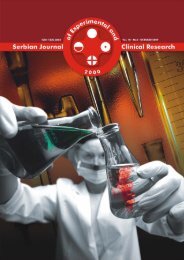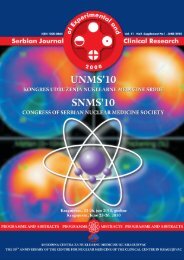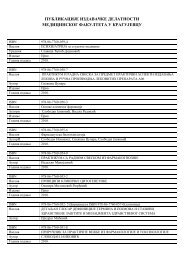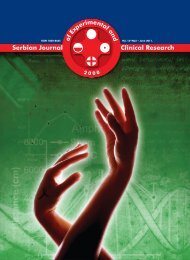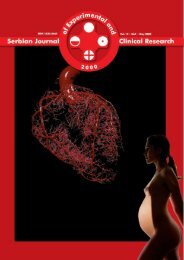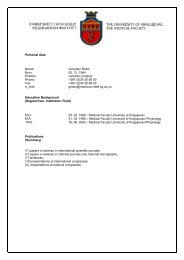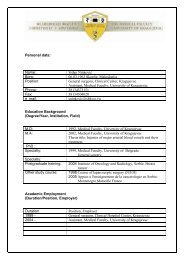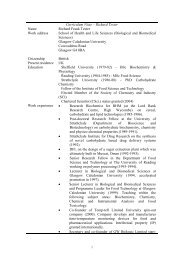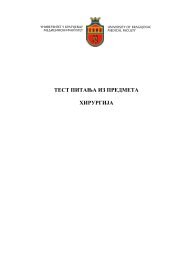neurotoxicity and mechanisms of induced hyperexcitability
neurotoxicity and mechanisms of induced hyperexcitability
neurotoxicity and mechanisms of induced hyperexcitability
Create successful ePaper yourself
Turn your PDF publications into a flip-book with our unique Google optimized e-Paper software.
B) Spontaneous modelsThe most frequently used spontaneous models <strong>of</strong> type1 diabetes are the non-obese diabetic (NOD) mouse <strong>and</strong>the bio-breeding (BB) rat. These two strains are the result<strong>of</strong> laboratory inbreeding (keen cross-breeding) <strong>of</strong> a largenumber <strong>of</strong> generations; they develop the disease spontaneously,similar to type 1 human diabetes.NOD mouseThe NOD mouse is an inbred, homozygous strain discoveredin 1974 in Shionogi Research Laboratories in Osaka,Japan. It was a result <strong>of</strong> keen cross-breeding from normoglycemicstrains used for cataract research (Jcl-ICR mouse) <strong>and</strong>bred in sterile conditions, free from species-specific pathogens(16). The NOD mouse developed insulitis detectable byelectronic microscopy after 2 weeks, <strong>and</strong> within 4-5 weeks itbecomes visible under st<strong>and</strong>ard microscopy (17). The infiltrationis mainly characterized by the presence <strong>of</strong> a large number<strong>of</strong> CD 4+ T lymphocytes, while CD 8+ T <strong>and</strong> B lymphocytes,as well as NK cells are not so numerous (18). Insulitis is progressive<strong>and</strong> accompanied by the destruction <strong>of</strong> beta cells <strong>and</strong>a decrease <strong>of</strong> insulin levels in serum. In contrast to the diseasein the human population, these strains have mild ketoacidosis<strong>and</strong> can survive for weeks without insulin substitution (1).Incidence <strong>of</strong> this disease differs between genders (90% amongfemales <strong>and</strong> 60% among males) (1).Similar to the human population, the main autoantigenesin pathogenesis <strong>of</strong> this disease, recognized by secreted antibodies,are insulin, glutamic acid decarboxylase (GAD), <strong>and</strong>tyrosine phosphatase (ICA512, known as IA-2) (19).The genetic background <strong>of</strong> diabetes in this model highlightsthe role <strong>of</strong> a major histocompatibile complex (MHC) class IIgene that codes for molecule I-A g7 (20-21). The expression <strong>of</strong>MHC molecule class I refers to proteins K d <strong>and</strong> D b (22). An alteration<strong>of</strong> INS gene expression, controlling the expression <strong>of</strong>insulin in the thymus <strong>and</strong> the deletion <strong>of</strong> T reactive lymphocytesin the case <strong>of</strong> central tolerance, is related to an initiation<strong>of</strong> the autoimmune process (22). A similar situation is observedwith the cytotoxic T lymphocyte antigen 4 (CTLA-4) gene,which codes for a negative signal molecule for CD8+ T cells<strong>and</strong> controls the activation <strong>and</strong> expansion <strong>of</strong> T lymphocytes(22). The protein tyrosine phosphatase non-receptor type 22(PTPN22) gene, associated with autoimmune diabetes, codesfor tyrosine phosphatase (LYP or PEP), a negative regulator<strong>of</strong> T cells (22). Variations <strong>of</strong> genes coding for IL2 <strong>and</strong> CD25FoxP3 + that a key role in maintaining immune homeostasis arecommon for both human <strong>and</strong> NOD mice (22).BB ratThe BB rat was discovered in 1974 within the commercialcampaign <strong>of</strong> the Company Bio Breeding Laboratories, Ottawa.It develops diabetes spontaneously (decrease <strong>of</strong> bodyweight, polyuria, polydipsia, hyperglycemia <strong>and</strong> insulopenia)during puberty—approximately the 12 th week <strong>of</strong> life (1). Similarto the human population, the BB rat develops serious/fatalketoacidosis unless insulin substitution is administered. (1)The disorder is autoimmune, <strong>and</strong> insulitis is characterized bythe infiltration <strong>of</strong> T lymphocytes, B lymphocytes, macrophages<strong>and</strong> NK cells (23). Typical for this species is extreme lymphopeniaassociated with a decreased number <strong>of</strong> T lymphocyteswith an elevated expression <strong>of</strong> ADP-ribosyltransferase 2(ART2); this has not been registered in the human population(24). A transfusion <strong>of</strong> histocompatible T ART2+ lymphocytesprevents spontaneous hyperglycemia in this model (24).Recent studies show that BB rat diabetic syndrome is acomplex, polygenic disease that may share additional susceptibilitygenes aside from MHC class II with human type1 diabetes (25). The expression <strong>of</strong> two main susceptibilitygenes is responsible for the development <strong>of</strong> diabetes inthe BB rat: MHC (RT1) class II u haplotype (Iddm1) <strong>and</strong>the Gimap5 (GTPase immunity associated protein familymember 5) gene, a key genetic factor for lymphopenia inspontaneous BB rat diabetes (Iddm2) (25).EXPERIMENTAL MODELS OFTYPE 2 DIABETESA) Induced modelsC57BL/6J mouse fed a high-fat dietThis model was originally introduced by Surwit et al. in1988 as a robust model <strong>of</strong> impaired glucose tolerance (IGT)<strong>and</strong> early type 2 diabetes (26). C57BL/6J mice fed a high-fatdiet (58% energy by fat, a “Western diet”) developed hyperglycemia,hyperinsulinemia, hyperlipidemia <strong>and</strong> increasedadiposity (27). High-fat diet results in insulin resistance withcompensatory hyperinsulinemia. After one week on the diet,baseline plasma glucose <strong>and</strong> insulin are significantly elevated<strong>and</strong> intravenous glucose tolerance test (IVGTT) shows reducedglucose elimination <strong>and</strong> impaired insulin secretion(28). The model thus shows two important pathophysiologicalcharacteristics for impaired glucose tolerance (IGT) <strong>and</strong>type 2 diabetes: insulin resistance <strong>and</strong> islet dysfunction.In this model, the weight gain is due primarily to anincrease in mesenteric adiposity. In high-fat diet-fed mice,energy intake is higher <strong>and</strong> metabolic efficiency index islower compared to normal diet-fed mice (28). Despiteobesity, plasma leptin levels are significantly lower than inthe control group in the absence <strong>of</strong> hyperphagia (29). Increasedserum lipid levels develop concomitantly with thedevelopment <strong>of</strong> hyperglycemia, thus deteriorating insulinresistance <strong>and</strong> producing lipid deposits in non-adiposecells, including beta cells <strong>and</strong> skeletal muscle cells (30).Microscopically, a high-fat diet induces hypertrophy <strong>of</strong>pancreatic islets (31).This model is suitable for examining novel therapeuticinterventions. The dipeptidyl peptidase-IV (DPP-IV) inhibitoris efficient in improving glucose tolerance <strong>and</strong> insulinsecretion in the high-fat diet-fed mouse model (28).Partial pancreatectomy as a surgical method <strong>of</strong> inducingdiabetes was described above.31



